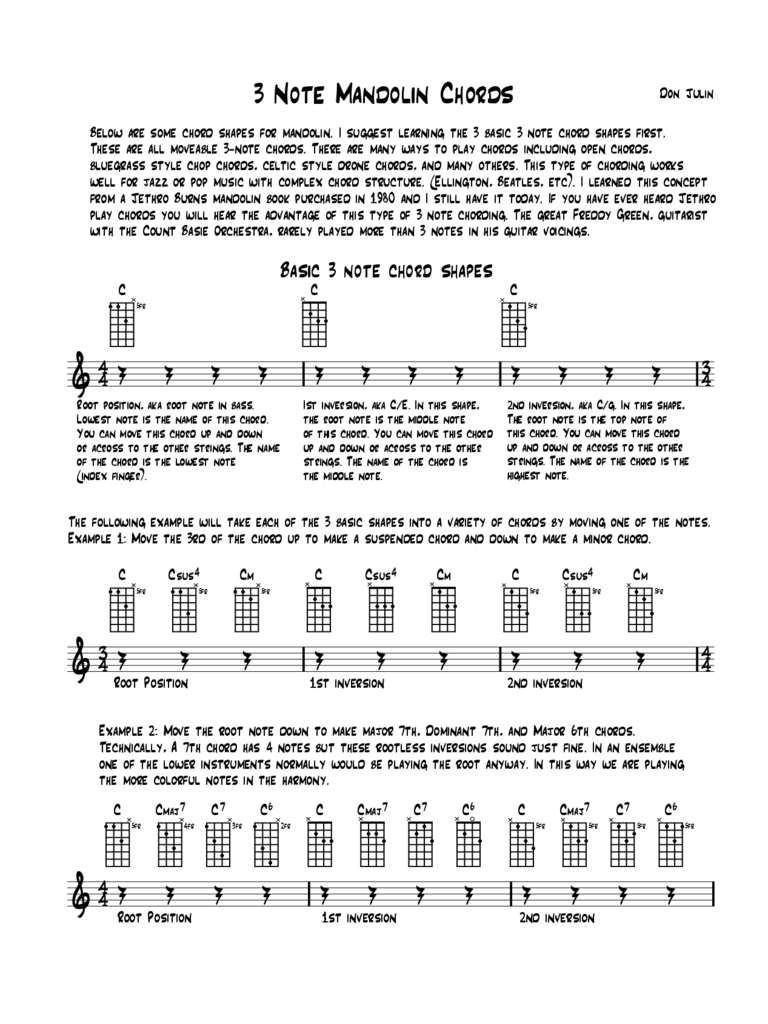Fillable Printable Sample Mandolin Chords
Fillable Printable Sample Mandolin Chords

Sample Mandolin Chords

3 Note Mandolin Chords
Don Julin
Root position, aka root note in bass.
Lowest note is the name of this chord.
You can move this chord up and down
or across to the other strings. The name
of the chord is the lowest note
(index finger).
Below are some chord shapes for mandolin. I suggest learning the 3 basic 3 note chord shapes first.
These are all moveable 3-note chords. There are many ways to play chords including open chords,
bluegrass style chop chords, celtic style drone chords, and many others. This type of chording works
well for jazz or pop music with complex chord structure. (Ellington, Beatles, etc). I learned this concept
from a Jethro Burns mandolin book purchased in 1980 and I still have it today. If you have ever heard Jethro
play chords you will hear the advantage of this type of 3 note chording. The great Freddy Green, guitarist
with the Count Basie Orchestra, rarely played more than 3 notes in his guitar voicings.
5fr
C
Basic 3 note chord shapes
Ist inversion, aka C/E. In this shape,
the root note is the middle note
of this chord. You can move this chord
up and down or across to the other
strings. The name of the chord is
the middle note.
C
2nd inversion, aka C/g. In this shape,
The root note is the top note of
this chord. You can move this chord
up and down or across to the other
strings. The name of the chord is the
highest note.
5fr
C
The following example will take each of the 3 basic shapes into a variety of chords by moving one of the notes.
Example 1: Move the 3rd of the chord up to make a suspended chord and down to make a minor chord.
Root Position
5fr
C
5fr
Csus4
5fr
Cm
1st inversion
C
Csus4
Cm
2nd inversion
5fr
C
5fr
Csus4
5fr
Cm
Example 2: Move the root note down to make major 7th, Dominant 7th, and Major 6th chords.
Technically, A 7th chord has 4 notes but these rootless inversions sound just fine. In an ensemble
one of the lower instruments normally would be playing the root anyway. In this way we are playing
the more colorful notes in the harmony.
Root Position
5fr
C
4fr
Cmaj7
3fr
C7
2fr
C6
1st inversion
C
Cmaj7
C7
C6
2nd inversion
5fr
C
5fr
Cmaj7
5fr
C7
5fr
C6

The following example did not make it onto the video. Example 3: Move the 5th of the chord up to make
augmented, Major 6th, and dominant 7th chords. I did not include the c7 in first inversion because I
think it is impractical.
5fr
C
Root Position
5fr
Caug
5fr
C6
5fr
C7
1st inversion
C
Caug
3fr
C6
2nd inversion
5fr
C
6fr
Caug
7fr
C6
7fr
C7
Next is the minor chord family with the root note moving down to make minor (major 7th), minor 7th,
and minor 6th chords. I am sure you have noticed by now that many of these chords have more than one name.
Root Position
5fr
Cm
4fr
Cm[maj7]
Cm7
Cm6
1st inversion
Cm
Cm[maj7]
Cm7
Cm6
2nd inversion
5fr
Cm
5fr
Cm[maj7]
5fr
Cm7
5fr
Cm6
This final example did not make the video either. These are minor chords with the 5th of the chord moving up to
make minor flat 6, minor 6th and minor 7th chords. Some of these are pretty esoteric and downright strange.
You might be asking yourself "where the heck would I ever use these chords"? Just for fun, play the below
examples in this order: Cminor/Cminor flat 6/Cminor 6/Cminor flat 6. Sound Familiar? this should sound like
the chords from the Secret Agent Man Theme (Oh Boy- Now I am really revealing my age). Anyway if you were
content playing G/C/D you would not be here! Have fun with these. Take it slow and learn one chord family
at a time. I think you will be glad you did.
Root Position
5fr
Cm
5fr
Cmb6
5fr
Cm6
5fr
Cm7
1st inversion
Cm
Cmb6
Cm6
2nd inversion
5fr
Cm
6fr
Cmb6
6fr
Cm6
6fr
Cm7
2



